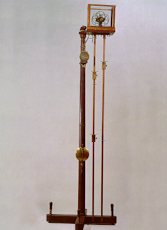
222 x 75 x 75
Brass, iron, glass and wood
INDEX 1790 : B.III.IV.83
Nova Dynamices Machina ab Atwoodio inventa, qua praecipue confirmantur experientia leges, quas sequuntur corpora motu rectilineo ac rotatorio agitata. Vid. Atwoodii Opus, cujus Titulus est A Treatise on the rectilinear motion and rotation of bodies &c. Cambridge 1784. pag. 291. Fig. 78. vel Magellan. Description d'une Machine nouvelle de Dynamique inventée par Mr. G. Atwood a Londres 1780.
New dynamics machine invented by Atwood used to conduct experiments that prove the laws of motion of bodies that follow a rectilinear and rotational motion. Atwood book, entitled "A treatise on the rectilinear motion and rotation of bodies &c." Cambridge, 1784, p.291, Fig. 78 or Magellan's "Description d'une Machine nouvelle de Dynamique inventée par Mr. G. Atwood a Londres 1780" are two references to be noted.
Countless methods have been developed to obtain the relationship between the distance travelled by a moving body and the time necessary to travel that distance. The Atwood machine assumes an outstanding place in this research. As a matter of fact during almost two centuries, until recently, it was the best machine invented for this study.
The Atwood machine in the Gabinete de Física at the University of Coimbra is, without doubt, one of its most valuable pieces, not because of the materials it is built from, or for its elegance, but because it was one of the first copies of the famous Atwood machine made during the inventor's lifetime, and also because it was part of the scientific material sent from London by John Hyacinth Magellan, a Portuguese scientist recognised throughout the world at that time. In the Index, dalla Bella mentions as a bibliographical reference the pamphlet that Magellan published in London in 1780 which consists of a letter addressed to Volta, in which our compatriot describes the machine invented by Atwood. Dalla Bella felt proud to possess such an instrument and for this thanked God. This is how it is referred to in Physices Elementa (Vol. I, p. 60): "eximia Machina Celeberrimi Atwoodi, quae, Deo dante, in Theatro Physices ostendemus".
The Atwood machine consists essentially of a pulley on a horizontal axle. A long string, passing through the pulley's groove, holds two bodies of equal masses, one at each end. Each of the bodies is a small brass disk, 4.4 cm in diameter from whose centre a metallic 8 cm rod extends. Placing one of the bodies at a significantly higher level than the other and loading that one with another body of a smaller mass, the system moves vertically, with a uniformly accelerated motion, whose acceleration depends on the values of the equal masses of the bodies suspended and on the mass of the body which was added.
To minimise the effect of the friction on the axle of the pulley, the pulley is mounted on the periphery of another four pulleys which allow for greater mobility of the first. This assemblage is installed on the top of the machine, on two parallel wooden columns, being held up by a cylindrical wooden column which rises from a base in the shape of a cross. On the ends of each beam of the base there is a very large wooden screw, which is used to level the machine. The two columns (rulers) along which the two parts of the string that suspend the masses run, are graduated in inches, from 0 to 72, with each inch subdivided into 10 equal parts. These rulers allow the measurement of distances covered by the bodies suspended on the string. Other accessories can be installed on them for the realisation of experiments. Thus, three moveable cursors can be fixed to them, one of which is full and the other two empty. The full cursor allows us to define the final position of the movement and the other two cursors are used to retain the weights that, in some experiments are placed on the bodies.
On another column a weight operated clock is installed with a pendulum that, as it moves, makes a bell, mounted at the top of the clock-face, ring every second. In the centre of the surface of the pendulum, the following inscription can be read: J.H. Magellan Lusitanus invenit atque fiere Curavit Londoni. John Hyacinth Magellan not only informs us that he was associated with the construction of the Atwood machine in London, but also declares that the pendulum which is found there is his own invention. Of the various papers published by thisdistinguished compatriot we must refer to the Notice des instrumens d'Astromomie, de Geodesie, de Physique, etc. Faits dernierement à Londres par ordre de la Cour d'Espagne: aves le précis de leur construction, qualités et Perfectionnements nouveaux, par J.H. de Magellan gentilhomme portuguais, etc. A Londres, etc. MDCCLXXX. It is in this paper that Magellan refers to the pendulum that he invented.
Also in the Gabinete de Física is a wooden box with the inscription B.III.582, the same as that which can be read on the machine. The box 32 cm x 27 cm x 21.5 cm has various divisions in it to hold a collection of brass pieces that were the objects used as weights and extra weights on the Atwood machine.
After the compilation of theIndex of 1788, dalla Bella acquired new machines, to which he attributed the identification numbers starting from 580 (the number of the last instrument in the Index). Some
of these machines were included in the Index of 1790, having been registered, however, alongside machines of the same type. In the case of the Atwood machine, although it has the inscription
B.III. ai. 582, it is described in the Index of 1790 under number 83, following the Poleni machine, which
was number 82.
Magellan, John Hyacinth, Collection de Différents Traités sur des Instruments d'Astronomie, Physique, etc. , Londres, 1780,
pp. 193-258. Londini.